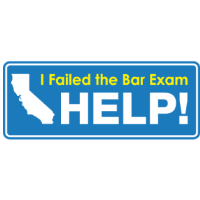The Upside in California’s Worst Bar Exam Scores in 30 Years

A couple weeks ago, Kyle McEntee, executive director of Law School Transparency, told the Los Angeles Times that California’s historically bad pass rate for the state bar exam, 48.6% in July 2014, was “not got to get better. If anything, it’s going to get worse.”
McEntee, who based his prediction on crummy Law School Admission Test (LSAT) scores, was right. The pass rate for the July 2015 bar exam (it’s given twice a year) was 46.6%. Repeat test takers actually drag the rate down. First-timers scored 60%, compared to 61.4% the year before. February pass rates are always lower (pdf) than July’s.
The good news: California is not Mississippi, where the pass rate dropped 27 points, compared to 2014. It was down 14 points in Vermont, 12 points in New Mexico, 11 points in Oklahoma and 10 points in Wisconsin. Actual test scores nationally were at their lowest since 1988.
Above the Law had to track the July pass rates back to 1986 to find an overall rate (44.4%) lower than California’s this year. Considering that the rate dropped 7.2 percentage points between 2013 and 2014, that doesn’t seem out of reach. The high during the 30-year period was 63.2% in 1994.
The last time the rate was north of 60% was 2008 (61.7%). The record high was 63.4% in the fall of 1962 and the low was 27.7% in the spring of 1983.
Exam scores have been dropping across the country for years, along with the number of bar applicants and first-year law students. Law school enrollment numbers haven’t been this low since 1973. Despite there being fewer lawyers seeking employment, their declining placement rates after graduation indicate a glut of legal practitioners remain.
U.S. Supreme Court Justice Warren Berger predicted in 1979, “We may well be on our way to a society overrun by hordes of lawyers, hungry as locusts, and brigades of judges in numbers never before contemplated.” But as Jeff Jacoby at the Boston Globe pointed out, there were 450,000 attorneys back then and 34,000 law students graduated each year.
Now, around 44,000 a year graduate and there are more than 1.2 million.
California’s bar exam is considered the hardest in the nation by some. Instead of just using bar passage rates to calculate the degree of difficulty, Robert Anderson, associate professor at the Pepperdine School of Law, made his assessment by running “a regression of the bar passage rate for each ABA-accredited school for 2010 and 2011 on the school's median undergraduate GPA and LSAT, with an indicator variable for each state, weighted by the number of takers at each school.”
It’s a pretty impenetrable methodology for anyone not scientifically inclined, but Anderson said the results matched the conventional wisdom in his neck of the woods.
Pepperdine associate professor of law Derek T. Muller says the lower scores are the inevitable result of dumbing down the admissions system. “The problem of lower standards at many law schools that began about four years ago appears to be coinciding with the decline of bar pass rates,” he wrote on his blog Excess of Democracy.
The three-day general bar examination (GBX) contains three parts, including a multiple-choice Multistate Bar Examination (MBE) that levels the playing field for comparison purposes. Californians notched a mean-scaled MBE score of 1,424, compared to 1,399 nationally, according to the state bar.
–Ken Broder
To Learn More:
California Bar Exam Results Reveal Worst Pass Rate in Nearly 30 Years—But It’s Not All Bad News (by Staci Zaretsky, Above the Law)
As Fewer Californians Pass the Bar, Are LSAT Scores an Early Indicator of Success? (by Jason Song, Los Angeles Times)
A Steep Slide in Law School Enrollment Accelerates (by Elizabeth Olson and David Segal, New York Times)
California Bar Exam Cut from Three Days to Two (by Joe Patrice, Above the Law)
State Bar Announces Results for July 2015 California Bar Examination (State Bar of California)
Are Dumber Students to Blame for Lowest State Bar Exam Scores in a Decade? (by Ken Broder, AllGov California)
- Top Stories
- Controversies
- Where is the Money Going?
- California and the Nation
- Appointments and Resignations
- Unusual News
- Latest News
- California Forbids U.S. Immigration Agents from Pretending to be Police
- California Lawmakers Urged to Strip “Self-Dealing” Tax Board of Its Duties
- Big Oil’s Grip on California
- Santa Cruz Police See Homeland Security Betrayal in Use of Gang Roundup as Cover for Immigration Raid
- Oil Companies Face Deadline to Stop Polluting California Groundwater





